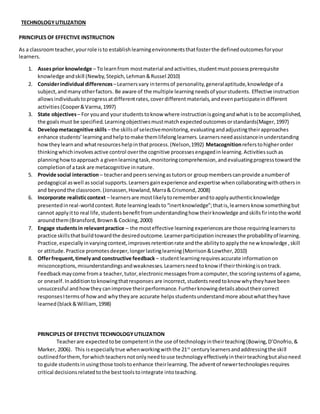
Technology utilization
- 1. TECHNOLOGYUTILIZATION PRINCIPLES OF EFFECTIVE INSTRUCTION As a classroomteacher,yourrole isto establishlearningenvironmentsthatfosterthe definedoutcomesforyour learners. 1. Assesprior knowledge – To learnfrom mostmaterial andactivities,studentmustpossessprerequisite knowledge andskill (Newby,Stepich,Lehman&Russel 2010) 2. Considerindividual differences –Learnersvary intermsof personality,generalaptitude,knowledge of a subject,andmanyotherfactors. Be aware of the multiple learningneedsof yourstudents. Effective instruction allowsindividualstoprogressatdifferentrates,coverdifferentmaterials,andevenparticipateindifferent activities(Cooper&Varma,1997) 3. State objectives– For youand your studentstoknow where instructionisgoingandwhatis to be accomplished, the goalsmust be specified.Learningobjectivesmustmatchexpectedoutcomesorstandards(Mager,1997) 4. Developmetacognitive skills – the skillsof selectivemonitoring,evaluatingandadjustingtheirapproaches enhance students’learningandhelptomake themlifelonglearners.Learnersneedassistanceinunderstanding howtheylearnand whatresourceshelpinthatprocess.(Nelson,1992) Metacognitionreferstohigherorder thinkingwhichinvolvesactive control overthe cognitive processesengagedinlearning.Activitiessuchas planninghowtoapproach a givenlearningtask,monitoringcomprehension,andevaluatingprogresstowardthe completionof atask are metacognitive innature. 5. Provide social interaction– teacherandpeers servingastutorsor groupmemberscanprovide anumberof pedagogical aswell associal supports.Learnersgainexperience andexpertise whencollaboratingwithothersin and beyondthe classroom.(Jonassen,Howland,Marra& Crismond,2008) 6. Incorporate realisticcontext – learnersare mostlikelytorememberandtoapplyauthenticknowledge presentedinreal-worldcontext.Rote learningleadsto“inertknowledge”;thatis,learnersknow somethingbut cannot applyitto real life,studentsbenefitfromunderstandinghow theirknowledge andskillsfirintothe world aroundthem(Bransford,Brown& Cocking,2000) 7. Engage studentsin relevantpractice – the mosteffective learning experiencesare those requiringlearnersto practice skillsthatbuildtowardthe desiredoutcome.Learnerparticipationincreasesthe probabilityof learning. Practice,especiallyinvaryingcontext,improvesretentionrate andthe abilitytoapplythe new knowledge ,skill or attitude.Practice promotesdeeper,longerlastinglearning(Morrison&Lowther,2010) 8. Offerfrequent,timelyand constructive feedback – studentlearningrequiresaccurate informationon misconceptions,misunderstandingsandweaknesses.Learnersneedtoknow if theirthinkingisontrack. Feedbackmaycome froma teacher,tutor,electronicmessagesfromacomputer,the scoringsystemsof agame, or oneself.Inadditiontoknowingthatresponses are incorrect,studentsneedtoknow whytheyhave been unsuccessful andhowthey canimprove theirperformance.Furtherknowingdetailsabouttheircorrect responsesItermsof howand whytheyare accurate helpsstudentsunderstandmore aboutwhattheyhave learned(black&William,1998) PRINCIPLES OF EFFECTIVE TECHNOLOGYUTILIZATION Teacherare expectedtobe competentinthe use of technologyintheirteaching(Bowing,D’Onofrio,& Marker, 2006). This isespeciallytrue whenworkingwiththe 21st centurylearnersandaddressingthe skill outlinedforthem,forwhichteachersnotonlyneedtouse technologyeffectivelyintheirteachingbutalsoneed to guide studentsinusingthose toolstoenhance theirlearning.The adventof newertechnologiesrequires critical decisionsrelatedtothe besttoolstointegrate intoteaching.
- 2. The National EducationTechnologyStandardsforStudents(NETS-S),notedinthe followinglist especiallyoutline expectationsforstudentsuse of technologytoguide theirlearning(InternationalSocietyfor TechnologyinEducation[ISTE],2007). Creativityandinnovation Creativityisthe capabilityoractof conceivingsomethingoriginal orunusual. Innovationisthe implementationof somethingnew. Communicationandcollaboration Researchandinformationfluency Critical thinking,problemsolving,anddecisionmaking Digital citizenship Technologyoperationandconcepts Many of these standardsaddressthe essential elementsforsuccessinacquiring21st centuryknowledgeandskills. Teacheralsohave standardsfor acquiringthese skills.Theseare alsoprovidedbythe ISTEnamely; Studentlearningandcreativity Digital-age Learningexperiencesand assessments Digital-age workandlearning Digital citizenshipandresponsibility Professionalgrowthandleadership As a teacher,youwill be expectedtoenhance students’abilitiestoengage inthe use of technologytosupporttheir learningandaddressesthese sixareasof competency,alsoknownas technologyliteracyskills. You can combine knowledge andskillsrelatedtocontentareasandinformationliteracyskill byusingtechnologyinways that helpstudentslearninformationandcommunicate knowledge.Forexample,inascience lessononweather,youcan presentaproblemtoyour studentsthatwill require themtosearchwebsitesfordataor information,use communicationtoolstocollaborate withoutside experts,generate solutionstothe problemcollaboratively,andpresent theirideastoclassmatesusingcreative resources.Byapproachingyourinstructioninthatmanner, youhave addressed manyof the standardsby whichyourstudentswill be measuredandwill be givenguidedpractice indevelopingtheir knowledge skill. PRINCIPLES OF EFFECTIVE MEDIA UTILIZATION We are continuallylearningfrommultiplesourcesof mediathatprovide uswithinformationandchallenge ourthinking. As usersof these sources,we need medialiteracyskill toknow how toaccess them, how to understandandanalyze the content, andhowto create newmediamessages(Stanbury,2009) Text,television,videoandahost of othermediasourcesthat will be coveredwithinthistextbookare all valid andvital sourcesof information.Yourrole isto guide yourstudentstouse these media assourcesfortheirlearninginwaysthat are wise,safe andproductive.Forexample,studentsneedtolearntofindmultiple sourcestoverifyfactstheymayhave heardon the televisionnews.Theyneedtolearntobe critical usersof these resourcestoensure thattheyare well informed andtheirconclusionsare accurate.Asmentionedearlierthe ISTENETS-Saddressmanyof skill learnersneedto be successful consumersof the mediaresourcessurroundingthem. Furthermore,youteachingapproachshould provide studentwithopportunitiestoexplore how touse these media resourcestocommunicate theirknowledge.
- 3. PRINCIPLES OF EFFECTIVE TEXT UTILIZATION Textiseverywhere instudents’learning experiences. Textmaterialsinclude textbooks,fictionand nonflictionbooks, newspapers,booklets,computerscreen,magazines,studyguides,manualsand worksheets,aswell asword-processed documentspreparedbystudentsandteachers.The abilitytouse textasa meanstogather informationsorto communicate is knownas text literacy.The twoaspectsto becomingliterate ininthe use of textaspart of leaning processare ReadingandWriting.Readingisthe abilitytolookattextandgather knowledgefromthe message.Writing isthe abilitytogenerate text throughtoolssuchaspencils,pensorcomputerstocommunicate. ADVANTAGES AVAILABILITY–text-basedmaterialsare readilyavailable onavarietyof topicsand inmanydifferentformats. FLEXIBILITY – textisadaptable tomany purposesandmaybe usedin any well-litenvironment. Portability –textare easilycarriedfromplace anddo not require anyequipmentorpowersupply. USER FRIENDLY– properlydesignedtextmaterialsareaeasytouse,requiringnospecial effortto"navigate“ throughthem LIMITATIONS READINGLEVEL – some studentsare nonreaders;otherslackadequate literacyskillfortextmaterialsabove theirreadinglevel.Stillotherslackthe prerequisite knowledgetocomprehendthe vocabularyandterminology. MEMORIZATION – some teachersrequire studentstomemorize manyfactsanddefinitions,whichdiminishes textmaterialstomere memorizationaids. VOCABULARY– some textbooksintroduce alarge numberof vocabularytermsandconceptsina short amount of space,placingaheavycognitive burdenonstudents,whichmaybe overwhelmingforsome. ONE WAY PRESENTATION –because mosttextmaterial are not interactive,theytendtobe usedina passive way,oftenwithoutcomprehension. CURRICULUM DETERMINATION – Sometime textbooksdictate the curriculumratherthatsupportingit.Textbook oftenwrittentoaccommodate the curriculumguidelinesof particularstatesorprovince.Consequently, the prefencesof these authoritiesdisproportionatelyinfluence textbookcontentanditstreatment. CURSORY APPRAISAL–Selectioncommitteesmightnotexaminetextbookscarefully. INTEGRATION Teacherneedto understand the bestwaysto use textto facilitate learning.Designinggoodtext-basedmaterials involvesafewbasicelements; FONTCHOICE – selectclearfont.Selectonlyone ortwofonts. BACKGROUNDANDPATTERNS – Used backgroundthatare not busydistractingimages.Don’tsrimponthe page marginsor use space.Use double spacingandwide marginsforlearnersof all abilitylevelstoread. ARRANGEMENT– usedspace and textstyleslike boldanditalics. CHECK ANDREVISE – alwaysbe sure to proofreadyourmaterials. EVALUATION Considerall the typesof textbasedmaterialsaswell astheirindividual readingabilities.Addressmaterialsbytakingthe time to evaluate all readingmaterialsinyourclassroom.
- 4. WHEN TO USE TEXT-BASED MATERIALS GUIDELINES EXAMPLE Readingtextinformationforwhichtheywill be held accountable Studentsreadan assignedarticle fromanonline source Supplementingteacher-presentedmaterial Studentsuse librarybooks,encyclopedias,ornewspapers to add to theirknowledge of atopic. Usinghandoutsthat guide themthroughlearning activities Studentsuse astep-by-stepguide towrite abookreport Implementingthe Survey,Question,Read,Recite and ReviewMethod(SQ3R) Studentssurvey,askquestions,read,reciteandreview informationaboutthe bill of rights. USING TEXT MATERIALS Get learnersactivelyinvolvedwiththe materials.One techniqueistohave studentsuse the “SQ3R” method:Survey, Question,Read,Recite andReview Surveystage requiresstudentstoskimthroughthe textmaterial andreadthe overview and/orsummary. Questionstage requiresstudentstowrite alistof questionstoanswerwhile reading. Readstage,studentsare leadto lookforthe organizationof the material.Putbracketaroundthe mainides, underline supportingdetailsandanswerthe questionswritteninpreviousstep. Recite requiresthemtotestthemselveswhile readingad toput the contentintotheirownwords. Reviewsuggestthatstudents lookoverthe material immediatelyafterreadingit,the nestday,a weeklaterand so on.(Robinson,1946). Directstudentreadingwithobjectivesorquestionsandprovide aworksheetif one isnotincludedwiththe materials. Emphasize the use of visualsintextmaterialsandteachstudentstostudyvisualsinanefforttoincrease their comprehensionof the content.
